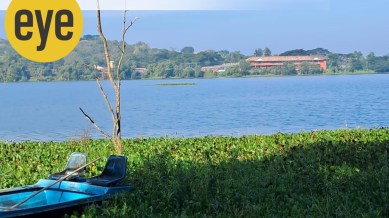What the Carambolim Lake in Goa offers birders
From grinning white-throated kingfishers to blue-tailed bee-eaters who are a lesson in beak-eye coordination to watching drongos compete with paradise flycatchers, the lake offers serenity and calmness in spades

Located very near Old Goa, this placid blue lake was reputed to attract large flocks of migratory waterfowl every winter, so a visit was in order. Apparently, it started life as a man-made water storage tank, way back at the times of the Kadambas who ruled Goa from the 10th to 14th century CE, to irrigate paddy fields, a purpose it still serves. Entirely rain-fed, its maximum depth is six meters, (normally between 1.5 to 3 meters) and it plays host to some 35,000 waterfowls every winter. (The maximum tally was 75,000 birds in 1987-88, when the rains failed in most of the country except Goa.)
Alas, all of which were MIA (missing in action) on the morning we visited the place. The lake is around 40 hectares and at the Western edge the Konkan railway nudges its shores and you can hear the announcements made at the Karmali railway station over the water, as trains sporadically arrive. As we thread our way down to the edge via a nature trail, a calmness and quietness envelopes us. The canopy above is broad-leafed and shady, the lake pristine, fringed with water hyacinth. There was another invasive floating weed here, going by the name Salvinia molesta aka Giant Salvinia, whose thick waterproof leaves formed a choking mat that prevented other water plants from photosynthesizing, and sucked up oxygen from the water, making life difficult for other plants, fish and insects. It had to be removed manually and with the help of machinery, though all of it could not be removed. It’s not an entirely evil plant because it also sucks up pollutants from the water and is being used for research in cancer: extracts from Salvinia can apparently destroy cancer cells without harming healthy ones.
monthly limit of free stories.
with an Express account.
But there we are scanning the lake for 35,000 pintail, shoveler, whistling teal, et al. and come up with zilch. Birding scores (such a favourite pastime of birders) range from 92 species (17 migratory) mentioned by Goa tourism, to a whopping 297 species ticked off by various birders over the years, on eBird, an online database of bird observations.
While the ducks were obviously, um…ducking, there were other birds to occupy our attention. Sleek silky black cormorants and darters holding up their spear bills skywards as if waiting for inspiration. Teenage darters look hilarious with white heads and streaky grey-brown bodies. Among the hyacinths, plump purple swamphen, stand around pensively like aunty jis who have suddenly run out of gossip. Grinning white-throated kingfishers have bagged nearly every stalk sticking out of the water, but then just ahead of us on one such stalk, blue-tailed bee-eaters give us a demo of beak-eye coordination. Snazzily masked, they have burnished chestnut throats, olive green bodies and turquoise tails out of which their tell-tale pin feathers stick out like antennae. They cock their heads this way and that, their eyes bright, then are off, in twisting turning in topsy-turvy flight and within seconds are back on their perches with something juicy in their beaks. Just think of the instant and complex computations their brains must make to achieve the manoeuver: insects fly like they’ve had six pegs too many, and to anticipate where one will be when you intercept it… well, try catching flies with a pair of tweezers or chopsticks and you’ll get the idea.
Far out there in the middle of the lake, a lazy osprey sits on a pole, and occasionally looks around and then tucks its head back into its wings for a quick snooze. It looks a bit bedraggled, so maybe it’s already done its breakfast fishing and is now just drying out and soaking up some sun. Purple herons, in mauve and copper, lean gently forward over the hyacinth, like some badminton players do before serving, their gimlet eyes rock steady.
There are viewpoints and watchtowers, too, along the banks, under one of which we settle to watch our bee-eaters. Here, the Forest Department keeps a register of visitors (there is no fee), the majority are locals, but there are British, European and Australian visitors, too. They have the semblance of a rescue centre here and in one cage, an injured Brahminy kite sits huddled, hopefully recovering from whatever ails it.
We walk down the forest trail, and a movement in the canopy catches our eye. A pair of sleek black birds seemingly being followed by two black paddles, which we realise they are attached to – racquet-tailed drongos. I’m delighted to make their acquaintance after so many years. Long ago, I nearly drove the car off the road at the Borivali National Park in Mumbai when they flew just in front of it. How they manage not to get their ‘paddles’ entangled in all that foliage is anyone’s guess.
And straightaway, the drongoes have competition. A paradise flycatcher, in white suit and tails, twisting and turning like a dervish among the leaves, its silky ribbon-like tail sketching the double helix and whatnot amid all those leaves. I’m only surprised that the bird doesn’t mistakenly snip off its own tail while jerking its head this way and that and back and forth as it hunts its prey. It would make an easy target for a raptor. Only the gents have the tail ribbons: a case of sexual selection scoring over natural selection – really, girls can be so demanding sometimes! Normally in cases like this, the showy male is excused from parenting duties because he’d attract unwelcome attention and can go philandering, but alas, gentlemen paradise flycatchers are not granted such liberties.
So, no waterfowl hordes perhaps but serenity and calmness in spades on the banks of Carambolim Lake.